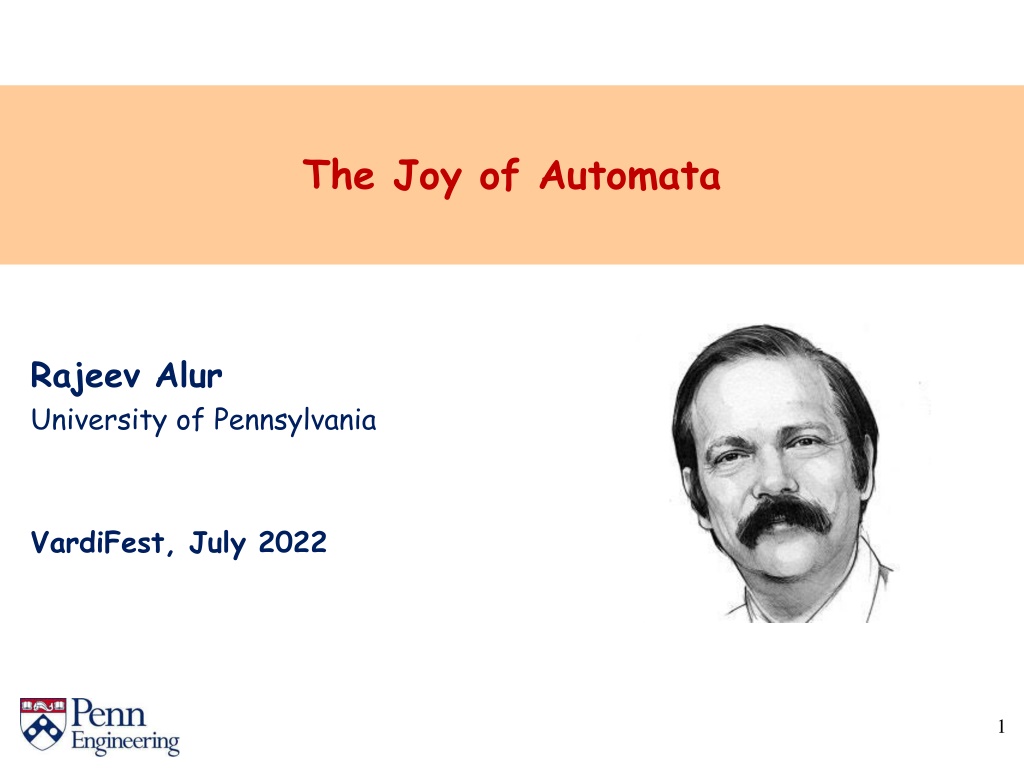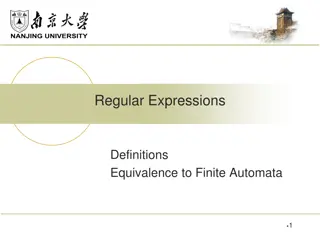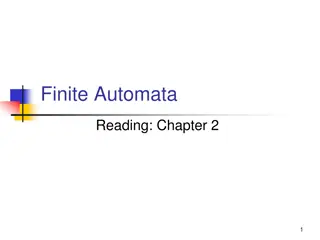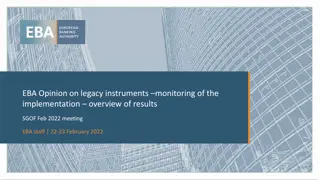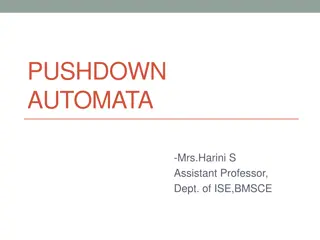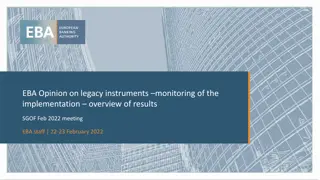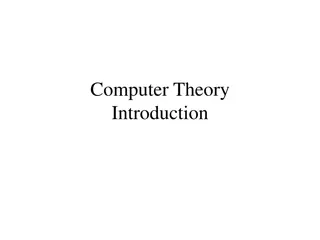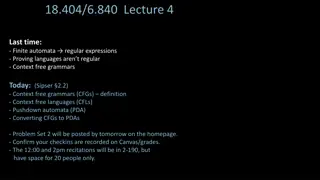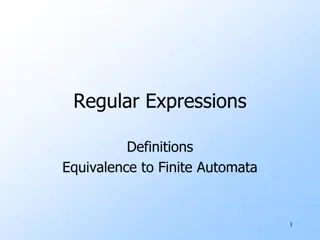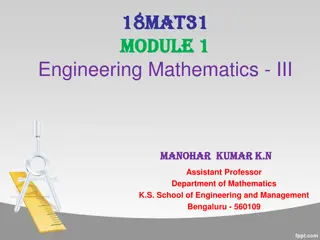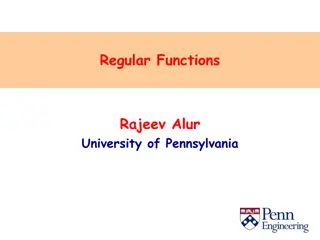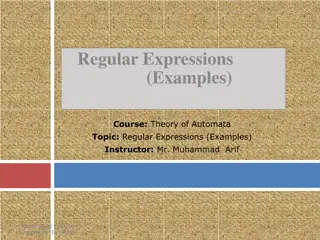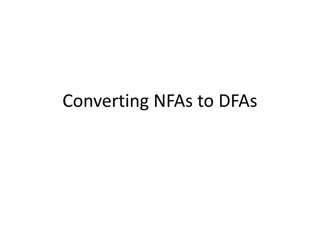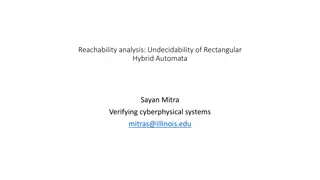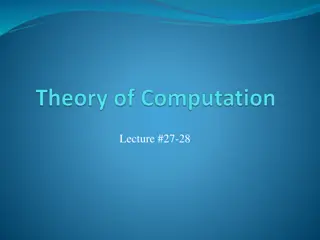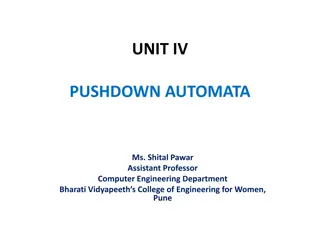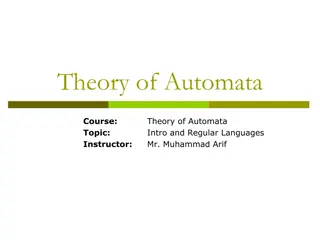Exploring the Legacy of Automata: Insights from Rajeev Alur at VardiFest 2022
Delve into the fascinating journey of Rajeev Alur's contributions to automata theory, from his early mentorship under Moshe Vardi to groundbreaking collaborations and key insights on automata over infinite words. Discover the essence of automata, its significance in decision problems, and the technical intricacies of deterministic and nondeterministic automata constructions.
Download Presentation

Please find below an Image/Link to download the presentation.
The content on the website is provided AS IS for your information and personal use only. It may not be sold, licensed, or shared on other websites without obtaining consent from the author. Download presentation by click this link. If you encounter any issues during the download, it is possible that the publisher has removed the file from their server.
E N D
Presentation Transcript
The Joy of Automata Rajeev Alur University of Pennsylvania VardiFest, July 2022 1
Gratitude for Decades of Mentorship My first job Intern, Summer 1990 Department of Mathematics and Related Computer Science IBM Almaden Research Center, San Jose, CA Manager: Moshe Vardi 2
PhD Thesis Committee Techniques for automatic verification of real-time systems (Timed automata) Stanford University, August 1991 3
Collaborations Parametric real-time reasoning Alur, Henzinger, and Vardi; STOC 1993 Alternating refinement relations Alur, Henzinger, Kupferman, and Vardi; CONCUR 1998 (CONCUR Test-of-Time Award) Theory in practice for system design and verification Alur, Henzinger, and Vardi; ACM SIGLOG News 2015 4
Three Pillars of CAV from Three Decades Ago Methodology: how to specify and verify properties ? Temporal logic Tools: how to scale to systems of practical interest? (Symbolic) Model checking Foundations: how to make CAV research intriguing ? Automata over infinite words/trees 5
Why Automata ? Specification Logics Decision problems Monadic Second-Order Logic (MSO) Temporal logic Mu-calculus Linear vs branching models Membership Satisfiability / Emptiness Equivalence / Implication Synthesis Automata Deterministic / Nondeterministic / Alternating For finite/infinite words/trees Automata constructions Determinization 6
Automata over Infinite Words: The Intrigue q,r p,r p Model: Infinite sequence over {p, q, r} Property: Every p is followed by q G ( p F q )Property: q Deterministic Buchi automaton q q G F p G F q If p repeats, so should q q,r Nondeterministic Buchi automaton Provably, no deterministic Buchi automaton exists! 7
Determinization of Automata over Infinite Words q p q p G F p G F q 2 1 r p r q 0 r Deterministic Parity automaton Highest repeating color should be even Technical challenge: Optimal translation from nondeterministic Buchi automata to deterministic parity automata 8
Time for Logics and Automata Executions of real-time systems modeled as timed words Sequence of events with non-decreasing real-valued time-stamps q p p, x:=0 Bounded response: G ( p F< 1 q ) Every p is followed by q within 1 unit x<1 & q (Deterministic) Timed automaton x=0 x=1 0 p p 1 2 Technical challenge: State-space is infinite due to real-valued clock variables but emptiness is decidable due to a finite-quotienting construction 9
The Curse of Punctuality x=0 x=1 0 p p 1 2 Exact Bounded response: G ( p F=1 q ) Not specifiable using timed automata! Intuitively need unboundedly many clock variables Property: Exist two events p and q exactly 1 time apart Specifiable using a nondeterministic timed automaton (but not deterministic) Nondeterministic not closed under complement, and not determinizable Equivalence of nondeterministic TA is undecidable 10
More Intrigue t t t+1 t +1 t+2 t +2 0 p p 1 2 3 MITL: Temporal operators with non-singular intervals: G ( p F(1,2) q ) Challenge: Time for every p in interval [0,1] is potentially relevant No obvious translation to timed automata But undecidability proofs crucially use singular intervals 11
MITL Satisfiability MITL property: G ( p F(1,2) q ) t t-1 t t -2 0 1 2 First q 3 Last q MITL can be effectively translated to nondeterministic TA Satisfiability is decidable (Expspace-complete) Alternative approach: Two-way deterministic timed automata 12
The Joy of Automata: A Personal Journey Real-time temporal logics (1989-94) Timed automata, 1990 Hybrid automata, 1993 Alternating-time temporal logic, 1997 Nested word automata and visibly pushdown languages, 2004 Streaming string transducers, 2011 Streaming tree transducers, 2012 Quantitative regular expressions, 2016 Automata over series-parallel graphs Ongoing work, joint with Caleb Stanford and Chris Watson 13
Talk Outline What are (Synchronized) Series-Parallel Graphs ? What s the motivation for this model ? Automata over SSPGs A robust theory of regular languages of SSPGs: review of results What s intriguing, theoretically ? 14
(Synchronized) Series Parallel Graphs Base case Sequential composition Ordered (ranked) parallel composition Unordered (unranked) parallel composition 15
SSPG Features A class of directed acyclic graphs Each SSPG has a unique source and unique sink Edges have types (colors) which capture shape Sequential Left-split / Right-split; Left-join / Right-join Unordered-split; Unordered-join Synchronization Unique path from source to sink by sequential and synchronized edges Vertices labeled with elements of finite alphabet 16
Modeling Data in Stream Processing Systems Input stream Output stream A starting point: A stream is a linear sequence of items of a data type If input/output data types are A/B, then an operator is a monotonic function from A* to B* Requiring all items to be strictly ordered is restrictive Relational query optimization not applicable: How to parallelize correctly ? Distributed systems have events that aren t causally related: Is overhead to force consistent ordering needed ? 17
Partially-ordered Semantics for Streams Input stream Output stream Beyond linear sequences: Relation that gets incrementally updated ? Sequence of relations (see CQL [Arasu et al, 2006] ) Sequences with punctuation markers (see [Maier et al, 2010]) What about streams partitioned on key values ? Unifying framework: View streams as labeled series-parallel graphs and operators as monotonic transformers over these Reference: Synchronization Schemas (Keynote, PODS 2021) 18
Illustrative Streaming Computation Different colors: different taxis GPS/BeginRide/EndRide events Ordering / synchronization constraints (a logical view): Events of the same taxi are linearly ordered All events are ordered w.r.t. EndOfDay synchronization events 19
Stream as a Series-Parallel Graph : EndOfDay synchronization events : GPS/BeginRide/EndRide events Different colors: different taxis Ordering constraints as a contract: For ordered items, implementation should enforce strict temporal order For unordered items, result of computation should not depend on exact order in which they get processed (or in parallel) 20
SSPGs and Distributed Stream Procesing Modeling data streams as series-parallel graphs Shape expressed by synchronization schemas Unordered parallel composition corresponds to key-based partitioning Facilitates correct parallel processing Unified foundation for semantics of many operators in stream processing Automata over SSPGs can capture integrity constraints over data: for each taxi, each day, BeginRide and EndRide events alternate though they cannot capture relational queries and aggregates 21
How to define Automata over SSPGs? Standrd: Finite set of states Q, initial state q0, accepting states F What about transition function ? Literature guide: Automata over trees, graphs, nested words Desired goal: a robust theory of regular languages Equivalent to MSO logic over such graphs (this definition is fixed!) Closed under Boolean operations, homomorphism/projection Determinization (note: not possible for (series-parallel) graph automata) Decidable emptiness and equivalence 22
Defining Transition Function Sequential, Ordered split, and unordered split edges: single predecessor seq : Q x Q ordered-split : Q x Q x Q unordered-split : Q x Q Note: at an unordered split vertex, A sends the same state to all children In nondeterministic version, RHS is a set of states (or pairs of states) At unordered split, different children may get different states 23
Transition Function for Ordered Join State determined by states at the three predecessors ordered-join : Q x Q x Q x Q 24
Transition Function for Unordered Join State determined by state at synchronization predecessor and multiset of states at join predecessors What are regular (MSO-definable) properties of a multiset? Boolean combination of predicates such as count of an item </=/> const Unordered-join transition function: Q x [Q [0..k]] x Q k : counting complexity of automaton A multiset S over Q is mapped to fS : Q [0..k] fS(q) = n < k if S contains n copies of q = k if S contains >=k copies of q 25
Examples of Regular Properties : labeled with EOD : labeled with B, E, G Each parallel subgraph between successive EOD, matches (B G* E)* Last B may not have matching E in subgraph, but at most 3 such subgraphs At least 5 parallel subgraphs Not regular: number of subgraphs between successive stages is same 26
Summary of Results: Expressiveness A language of SSPGs is regular if accepted by deterministic automata Thm: Regular languages are closed under union, intersection, complement, homomorphism, reverse, Thm: A nondeterministic automaton with n states and count k can be translated to deterministic one with 2^{n2} states and count n.k Thm: Expressiveness of deterministic automata increases with count, but for nondeterministic, count of 2 suffices Thm: Regular languages can be equivalently characterized by MSO as well as graded -calculus 27
Summary of Results: Decision Problems Membership: Does an automaton A accept a given SSPG G ? Linear-time for deterministic A PTime for nondeterministic A Emptiness: Given an automaton A, does it accept some SSPG ? PTime for nondeterministic A Inclusion: Does an automaton B accept every SSPG accepted by A ? PTime for deterministic B ExpTime-complete for nondeterministic B 28
The Role of Synchronization Edges Allows information to be passed directly from split vertex to matching join Inspired by call-return edges in nested words / visibly pushdown automata Crucial in determinization and MSO equivalence Example property: There is exactly one a-labeled vertex 29
Counting Complexity Property Ls: Graph contains s vertices combined by unordered parallel Deterministic case: Each parallel vertex returns same information At join must know whether the count is s or strictly less/greater than s Count must be s+1 Nondeterministic case: Nondeterministically send a state from {q1, qs} At join, require exactly one count of each qj (2 leads to rejection) Count of 2 suffices Regular properties are not bisimulation invariant Counting complexity of 1 Bisimulation invariant properties ! 30
Graded -calculus Variant of classical -calculus interpreted over labeled transition systems Propositions for state-labels Set variables and least/greatest fixpoint operators Boolean connectives Graded existential modality: <n,a> means n a-successors satisfy Graded universal modality: [n,a] means at most n a-successors satisfy History Introduced by Janin and Lenzi [LICS 01] Complexity over infinite trees: Kupferman, Sattler, and Vardi [CADE 02] Expressive Equivalence Graded -calculus can be translated to MSO [JL 01] Graded -calculus can encode regular SSPG languages Proof encodes accepting automaton runs over Reversed graphs 31
In Conclusion Thanks to Moshe for his mentorship, and for introducing me to the joy of automata and logics which still has unexplored challenges 32
